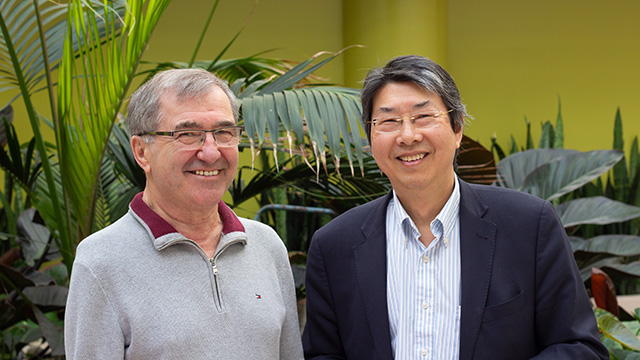
Bill Werny is a retired Canadian Air Force pilot, an active aerospace consultant and an engaged business leader. Werny, who grew up on a farm north of High Prairie, has lived a dynamic life despite undergoing spinal fusion surgery―twice.
In 1973, while in military college, Werny was in a motor vehicle accident where he broke his neck, resulting in a C1-C2 fusion. Even with the severity of his injury, through surgery, rehab and determination he made a full recovery and fulfilled his dream of pursuing a career in the Canadian military.
Werny went on to become an accomplished pilot, but given the demands of the job―vibrations from flying helicopters and high speed aircrafts compounded with wearing heavy night-vision goggles weighing down on his head―over time his injury began to impact his mobility and his condition gradually worsened. Eventually, he was forced to undergo surgery once again.
Post-surgery results were not optimal and Werny was left with little strength in his left hand and only partial use of his right. Being unable to bend his elbow or raise his hand above his head made daily tasks like cutting food, zipping jackets and tying shoes impossible.
Werny's story is similar to many others who are living with peripheral nerve damage. These patients experience paralysis, pain and/ or a loss of sensation in their limbs―a frustrating diagnosis that is often the result of a traumatic injury. A group of University of Alberta and Alberta Health Services experts are working to improve the lives of these patients.
Ming Chan, a clinician-scientist and a member of theNeuroscience and Mental Health Institute, is one of the experts who has played a major role as part of thePeripheral Nerve Injury Clinic team at the Glenrose Rehabilitation Centre. Chan and his colleagues treat approximately 200 patients every year (one of whom was Werny, who received a nerve transfer in February 2018).
The nerve transfer procedure is a day surgery that involves identifying the damaged nerve that is nearby the paralyzed muscle. Rather than transplanting a nerve from another area of the body, a redundant nerve from a nearby branch is spliced and connected to the muscles of the injured area to reconnect the pathway from the brain to the muscle.This means a shorter distance for the nerves to regenerate in order to restore movement.
The nerve transfer techniques being used at the Peripheral Nerve Injury Clinic are quickly becoming the standard, thanks to the integrated nature of the clinic; it brings together specialists from a variety of disciplines including plastic surgeons, psychiatrists, rehabilitation therapists and researchers to one space to work more efficiently and collaboratively and to enhance the experience for the patient.
Chan and his team's research in nerve transfer techniques and accelerating nerve growth has been applied in the clinic to improve outcomes and shorten recovery times. Information gathered from patients is also used to drive clinically relevant research in the lab thus allowing for seamless translation from the bench to bedside and back.
"Research in the lab and the services delivered at the clinic are tightly coupled," Chan said. "The research being done in the lab is helping the team at the clinic to develop new treatment options that will lead to improved outcomes. Conversely, working with each patient has provided valuable information that has provoked new questions, that can then be addressed by laboratory research."
It's been one year since Werny's nerve transfer procedure, and while he is still working through his rehabilitation, he is feeling marked improvement in the strength and mobility of his right arms.
"The procedure and physical therapy has improved my ability to perform some of my daily functions and has provided me with hope that the road ahead is positive," Werny said. "Being part of the trial program with Dr. Chan and his team is very exciting and I am pleased to be involved-I believe the efforts and work being done will benefit many others going forward."
Chan's research and trials with patients like Werny have led to new advancements in artificial intelligence technologies as well. Chan is collaborating with the U of A's interdisciplinary Bionic Limbs for Improved Natural Control (BLINC) Lab to explore how these nerve regeneration techniques could be synchronized to work with artificial limbs. The hope is that one day, amputees will not only use their prosthetics with ease, but would also experience sensations like movement and feeling, similar to someone with an intact limb.
Chan and Werny are both participating at an upcoming public lecture titled, "Changing Lives: New Technologies for Brain Health." The free event on March 14in the Allard Family Lecture Theatre (1-080 Katz Group Centre for Pharmacy and Health Research) is open to everyone. Come find out how technology is changing the way neuroscientists are discovering, understanding, and treating neurological disease and disorders.
Chan will be joined by three other leading UAlberta experts: Tejas Sakar (Brain Stimulation: Pacemakers for Brain Disease), Alan Wilman (Uncovering brain disease with MRIs) and Russ Greiner (Using AI Technology to detect psychiatric disorders).
For additional event or speaker information, visituab.ca/braintech.